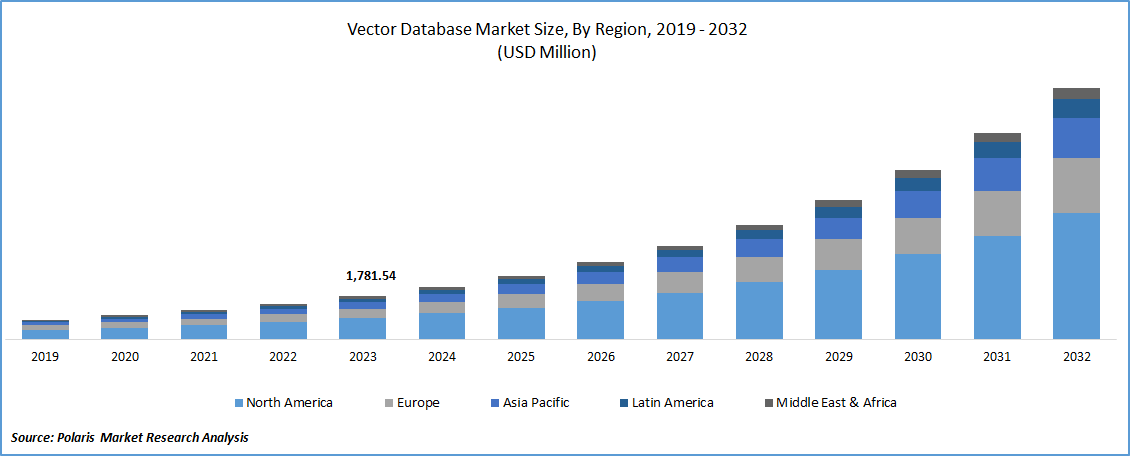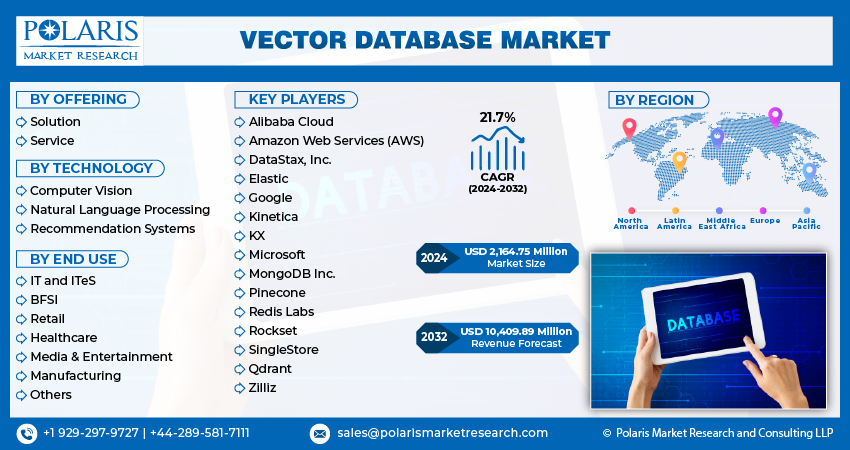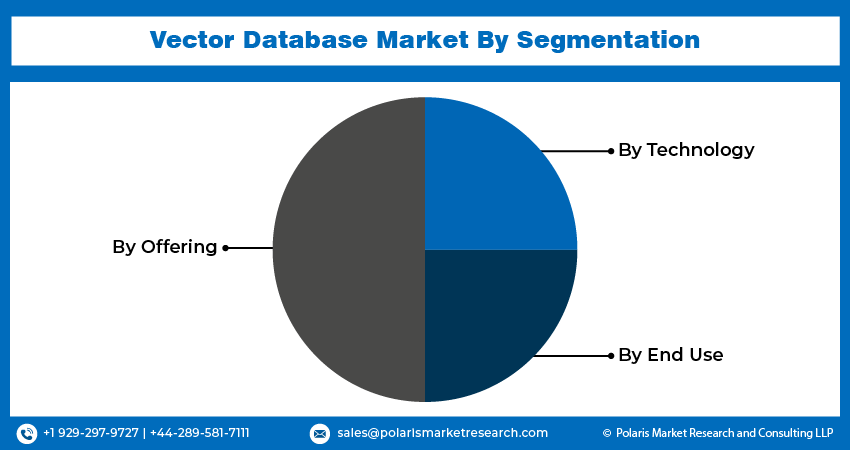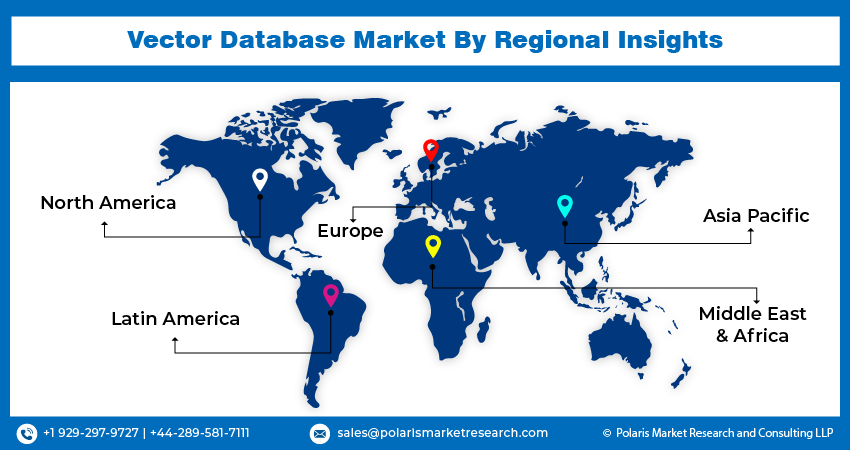
Vector Database Market Share, Size, Trends, Industry Analysis Report
By Offering (Solution, Service); By Technology; By End Use; By Region; Segment Forecast, 2024 - 2032
- Published Date:Feb-2024
- Pages: 115
- Format: PDF
- Report ID: PM4371
- Base Year: 2023
- Historical Data: 2019-2022
Report Outlook
The global vector database market was valued at USD 1,781.54 million in 2023 and is expected to grow at a CAGR of 21.7% during the forecast period.
The surge in machine learning and artificial intelligence applications mandates databases capable of effectively managing high-dimensional vector data. Vector databases play a vital role in supporting machine learning processes, accommodating the complexities of data required for training and inference. The increasing reliance on location-based services, navigation systems, and geospatial analytics across diverse sectors like logistics, urban planning, and agriculture fuels the demand for specialized vector databases. These databases are tailored to optimize the storage and retrieval of spatial data.
Ongoing research and development initiatives in the database sector fuel the growth of vector databases. Investments in innovation lead to the development of more sophisticated and specialized solutions. Market players are introducing new solutions to cater to the growing consumer demand.

To Understand More About this Research; Request a Free Sample Report
For instance, in September 2023, KX officially launched KDB.AI Cloud, a vector database tailored for real-time contextual AI. Offering a seamless and user-friendly setup, this complimentary cloud-based edition of KDB.AI is created to deliver an exceptional developer experience.
The surge in cloud computing adoption impacts the vector database market, revolutionizing data management. Cloud-native vector database solutions offer unparalleled scalability, accessibility, and collaboration. This shift enables seamless integration, optimizing resource use and aligning with the dynamic needs of high-dimensional data applications. Cloud-based vector databases foster efficient collaboration across distributed teams, accelerating innovation and reducing time-to-market. Their cost-effectiveness and flexibility provide wide access, making them more widely applicable in finance, healthcare, and machine learning.
The surge in machine learning applications, spanning recommendation systems, natural language processing, and image recognition provides a rich landscape for vector databases. These databases excel in managing intricate data structures, crucial for the training and deployment phases of machine learning models, presenting opportunities for integration and innovation. The shift towards edge computing offers opportunities for vector databases at the edge. Opportunities arise in addressing real-time processing needs for applications such as Internet of Things (IoT) devices and autonomous systems, where localized decision-making is critical.

Industry Dynamics
Growth Drivers
Rise of Big Data and Analytics and Real-time Analytics Requirements
The proliferation of vast datasets in finance, healthcare, and e-commerce necessitates advanced databases. Vector databases, adept at handling intricate data structures, have become pivotal for organizations seeking efficient storage and retrieval mechanisms in big data analytics.
The growing demand for real-time analytics in finance, IoT, and other sectors underscores the need for databases that can provide rapid access to vector data. Vector databases facilitate quick decision-making by ensuring efficient data retrieval for real-time analysis.
Vector databases cater to the unique data handling needs of various industries, such as genomics, finance, and telecommunications. Their adaptability to industry-specific requirements drives their adoption across sectors with distinct data characteristics.
Report Segmentation
The market is primarily segmented based on offering, technology, end use, and region.
|
By Offering |
By Technology |
By End Use |
By Region |
|
|
|
|
To Understand the Scope of this Report; Speak to Analyst
By Offering Analysis
The Solutions Segment Accounted for a Significant Market Share in 2023
In 2023, the solutions segment accounted for a significant market share. Vector database solutions specialize in managing complex, high-dimensional data, offering efficient storage and retrieval. These platforms, adaptable across industries, excel in geospatial analysis, machine learning, and genomics. Key features include spatial indexing for location-based tasks, optimized query mechanisms, scalability to handle growing data loads, and seamless integration with machine learning frameworks. Tailored solutions ensure effective handling of data, while real-time analytics support timely decision-making. Emphasizing flexibility, customization, and robust security measures, these solutions employ data compression techniques and incorporate graph database capabilities for managing interconnected data efficiently.
By Technology Analysis
The Natural Language Processing Segment Accounted for a Significant Market Share in 2023
In 2023, the natural language processing segment accounted for a significant market share. Natural Language Processing (NLP) enhances vector databases by enabling natural language queries, making them more accessible. It adds semantic understanding for precise searches and facilitates data annotation. NLP identifies entities within vector data, performs sentiment analysis on textual content, and aids language translation for multilingual contexts. Summarization features provide quick insights, and automated metadata generation offers contextual information. NLP ensures contextual understanding, contributing to a more intelligent database. Conversational interfaces enable users to interact in natural language, fostering a user-friendly and sophisticated experience, ultimately enriching the capabilities of vector databases in handling complex data with linguistic components.
By End Use Analysis
The It and Ites Segment Accounted for Significant Market Share in 2023
The IT and ITeS segment accounted for a significant market share in 2023. Vector databases prove invaluable in IT and ITeS sectors, excelling in data analytics, business intelligence, and machine learning applications. Essential for software development and testing, they efficiently manage diverse data types, catering to complex structures. Particularly beneficial for geospatial applications, these databases enhance mapping and navigation services. Customization, seamless integration, and high performance are crucial considerations, ensuring adaptability to specific IT needs. Security features, compliance with regulations, and scalability are paramount in handling sensitive data, supporting growth, and maintaining operational efficiency within the dynamic landscape of the IT and ITeS segments.

Regional Analysis
North America Accounted for the Largest Revenue Share in 2023
In 2023, North America accounted for the largest revenue share. Different sectors, including finance, healthcare, and e-commerce, exhibit unique data requirements. The specific needs of each industry influence the adoption of vector databases. Financial institutions require efficient handling of multidimensional financial data, while healthcare applications might focus on managing complex patient information in vector formats. Ongoing advancements in database technologies, particularly the development of specialized vector database solutions, contribute significantly to the market dynamics. The scalability, performance optimization, and seamless integration capabilities of these databases are critical factors that can impact their adoption in various industries, shaping the landscape of vector database solutions.
Asia-Pacific is expected to experience significant growth during the forecast period. In the Asia-Pacific region, characterized by its diverse technological landscape, the adoption of vector databases varies across countries. Leading the forefront are nations like China, Japan, South Korea, and India, each boasting robust technology ecosystems. The utilization of vector databases is influenced by factors such as the presence of skilled professionals and a general openness to embracing advanced technologies in these countries. The emerging markets in Southeast Asia and South Asia offer distinctive opportunities for providers of vector databases. With these regions undergoing rapid economic expansion, there is an escalating demand for sophisticated database solutions. Industries like e-commerce, logistics, finance, and healthcare in these burgeoning markets are propelling the adoption of vector databases to address evolving requirements in data management.

Key Market Players & Competitive Insight
The market faces fierce rivalry, with companies leveraging cutting-edge technology, top-notch product offerings, and a robust brand reputation to propel revenue expansion. Key players employ diverse tactics, including dedicated research and development, strategic mergers and acquisitions, and continuous technological advancements. These strategic maneuvers are aimed at broadening their product ranges and sustaining a competitive advantage. The market dynamic is shaped by constant innovation and a commitment to delivering high-quality solutions, underscoring the importance of strategic initiatives in ensuring sustained competitiveness.
Some of the major players operating in the global market include:
- Alibaba Cloud
- Amazon Web Services (AWS)
- DataStax, Inc.
- Elastic
- Kinetica
- KX
- Microsoft
- MongoDB Inc.
- Pinecone
- Redis Labs
- Rockset
- SingleStore
- Qdrant
- Zilliz
Recent Developments
- In December 2023, Salesforce unveiled substantial enhancements to its Einstein 1 Platform, introducing the Data Cloud Vector Database and Einstein Copilot Search. Integrated seamlessly into the Einstein 1 Platform, the Data Cloud Vector Database empowers AI, automation, and analytics, elevating decision-making and customer insights across the entire suite of Salesforce CRM applications.
- In September 2023, Timescale introduced Timescale Vector, providing developers the capability to construct scalable production AI applications using PostgreSQL. Positioned on Timescale's robust cloud PostgreSQL platform, Timescale Vector empowers developers to utilize a unified platform for overseeing relational data, vector embeddings, time-series data, analytics, and event data, serving as the foundation for advanced AI applications.
Vector Database Market Report Scope
|
Report Attributes |
Details |
|
Market size value in 2024 |
USD 2,164.75 million |
|
Revenue forecast in 2032 |
USD 10,409.89 million |
|
CAGR |
21.7% from 2024 - 2032 |
|
Base year |
2023 |
|
Historical data |
2019 - 2022 |
|
Forecast period |
2024 - 2032 |
|
Quantitative units |
Revenue in USD million and CAGR from 2024 to 2032 |
|
Segments covered |
By Offering, By Technology, By End Use, By Region |
|
Regional scope |
North America, Europe, Asia Pacific, Latin America, Middle East & Africa |
|
Customization |
Report customization as per your requirements with respect to countries, region, and segmentation. |
FAQ's
Alibaba Cloud, Amazon Web Services, Google, KX, Microsoft, Redis Labs, MongoDB Inc. are the key companies in Vector Database Market.
The global vector database market is expected to grow at a CAGR of 21.7% during the forecast period.
The Vector Database Market report covering key segments are offering, technology, end use, and region.
Rise of Big Data and Analytics are the key driving factors in Vector Database Market.
The global vector database market size is expected to reach USD 10,409.89 million by 2032
